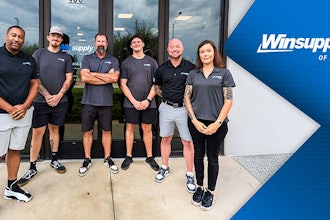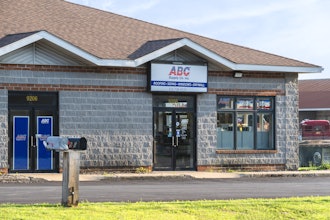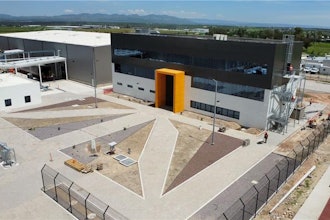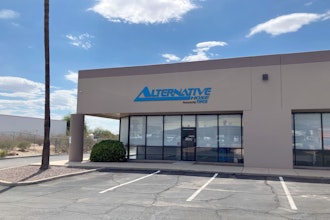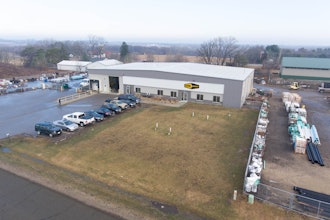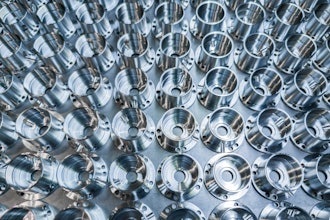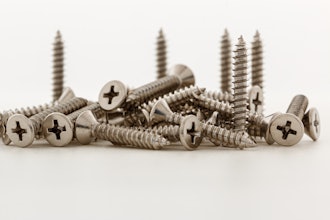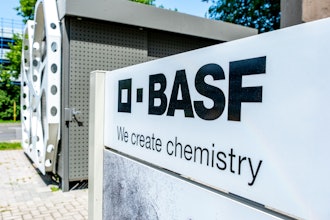
Autodesk
THE MODERNIZATION OF
PRODUCT DEVELOPMENT
HOW PROGRESSIVE TOOLS PROMISE TO
SAVE THE MULTI-TASKING ENGINEER
THE FUTURE OF MAKING THINGS 2
THE MEANS OF MAKING THINGS IS CHANGING
Remember when the concept of making things first emerged? It
was an impressive movement of professional grade artists,
hobbyists, tinkerers and more. It was inspiring. It was innovative.
It broke many rules that needed to be broken. But as remarkable
as it was, it didn’t stay the same. It morphed. Its methods,
practices and processes actually started to influence startup
product companies, who could easily adopt maker approaches to
their benefit. More recently, larger organizations are scrutinizing
the maker movement, trying to figure out how they can leverage
these impactful ideas.
Of course, the maker movement hasn’t just spread into
manufacturing startups and larger companies. It has also
transformed in terms of the types of things that are made. No
longer is it just about designing and manufacturing mechanical
stuff anymore. You now see electronics integrated into such
things in the form of embedded software and control systems.
And you especially see such things being hooked into the Internet
of Things. Today, objects that haven’t become connected and
smart are often seen as outdated antiques, waiting to be
obsoleted by a new crowd funded thing and its backers.
With a broadening scope in terms of the stuff that goes into these
things, there has been a need to take the professional tools often
seen in large manufacturers and make them more broadly
accessible to makers and startups. Traditional Computer Aided
Design (CAD), machining methods, Integrated Development
Environments (IDE) and coding for Internet connectivity can be
complex and, frankly, out of the reach of many. That, in turn, has
led to a quiet revolution in the tools that are used to make these
things.
The transformation of those tools into a new version of
themselves is the exact focus of this eBook. It starts by sharing
some research findings on how the work of today’s engineers
differs from those of the past. Next, it looks at the advantages
and disadvantages of both traditional and progressive toolsets,
comparing and contrasting them against one another. Finally, it
provides a recap and a few conclusions, offering guidance for
those looking at how to adopt more maker methods, practices
and processes.
The way that things are made has changed, and will continue to
change. New tools should be considered for those looking to
change along with it.
THE FUTURE OF MAKING THINGS 3
THE NEW CHALLENGES OF PRODUCT DEVELOPMENT
PHYSICAL LOCATIONS WHERE
ENGINEERS WORK
Hardware Design Engineer Study, January 2015, 350+ responses
Engineering has never been an easy job. Schedules are always
tight. Budgets are shrinking. Products are getting more complex.
Today, though, engineers are facing new demands that make
product development harder than ever. Findings from Lifecycle
Insights’ Hardware Design Engineering Study shed some details
on those challenges.
It is a fact: today’s engineers regularly spend a good amount of
time at their desk. Yet, that is rarely the only place they spend
their time. Findings from our study, shown in the figure on the
right, show that engineers also spend a significant amount of
time in conference rooms, manufacturing environments,
supplier’s campuses and customer’s offices. They are frequently
on the go.
With today’s compressed schedules, this becomes a major
challenge to staying on track with projects. Engineers often can’t
afford to wait until they get to their desk to resolve issues. They
need to resolve them on the go in order to keep the development
cycle from stalling. Organizations must find ways to eliminate
availability at a desk as a bottleneck for product development.
In addition to availability, though, efficiency is also critical. One
must be wary of how much time engineers spend on non-value-
added tasks at any point in product development, as it will
directly detract from the value-added tasks engineers could be
fulfilling.
Company’s Office Desk
Company’s Conference Rooms
Company’s Production Area
Customer’s Office
Supplier’s Office
4%
20%
Regularly
Occasionally
2% 97%
25% 58%
31% 40%
24% 7%
THE FUTURE OF MAKING THINGS 4
BALANCING MANY RESPONSIBILITIES
Another challenge that engineers face today is that they are
stretched incredibly thin. From a field of thirteen core and
extended design responsibilities, the same study asked
respondents to select which ones they fulfilled. On average,
engineers tallied a total of 4.4 core design responsibilities, which
included managing requirements, predicting product
performance and more. Furthermore, on average, engineers
tallied 2.9 extended design responsibilities, which includes things
like project management, collaborating with suppliers and more.
In all, that totals 7.3 responsibilities for the average engineer.
Note that making design decisions is only one of those
responsibilities.
This finding confirms that today’s engineers have a lot on their
plate and need assistance. Furthermore, it means they don’t have
the bandwidth to explore their design options to any reasonable
measure. They are too often forced to accept the very first
feasible design they encounter. For the company, that means
many opportunities in the design cycle are left on the table. That
includes the potential to reduce product costs, thereby increasing
profitability, incorporating innovative product features to out-
differentiate competitors and drive revenue growth and much
more.
IMPLICATIONS FOR THE PRODUCT DEVELOPMENT
Today, many things about the engineering environment are faster
paced than in years past, including the product development
cycle and engineers’ responsibilities. Engineers are called upon to
spend time on the manufacturing floor, in conferences, visiting
suppliers and on other tasks that take them out of their offices.
Furthermore, the Hardware Design Engineering Study found that
engineers have 7.3 responsibilities on average, only one of which
is making design decisions.
Because today’s engineers wear many hats and have limited time,
they may accept the first design they create that meets all design
requirements. They don’t have time to iterate to find the best
design possible, and this can affect product innovation and
organizational profitability. In light of the study’s findings,
organizations that wish to see maximum innovation and revenue:
Must find ways to ensure engineers can actively
participate while they are away from their desks so
product development doesn’t grind to a halt.
Must also eliminate non-value added tasks from
engineers’ routines, so they can contribute more to
product development.
Must find ways to automate and empower engineers to
explore and assess more design options.
THE FUTURE OF MAKING THINGS 5
TRADITIONAL DESIGN AND SIMULATION SOLUTIONS
A well-functioning, innovative product has its root in great design.
Product design is all about exploration and evaluation, iterating
again and again as the design is refined and honed. It is a cycle
that is repeated again and again, project after project. Of course,
engineers have been using advanced technology and software for
these tasks for decades. But do the traditional solutions address
these latest issues? This section answers that question.
TRADITIONAL MCAD, MCAE AND PDM SOFTWARE
Engineers use two tools to iterate on and evaluate designs:
Mechanical Computer Aided Design (MCAD) software and
Mechanical Computer Aided Engineering (MCAE) software. MCAD
software allows them to create and refine the 2D or 3D geometry
of designs. MCAE software enables engineers to simulate design
performance. These two tools enable engineers to develop
designs, iterate on them as well as check their physical
performance. Product data management (PDM) software is also
part of the design and simulation cycle. It acts as the central,
secure repository for design data, which must be checked in and
out of the system. As a whole, these three sets of software are
critical tools for any modern engineer.
THE DRAWBACKS OF TRADITIONAL SOLUTIONS
These traditional tools have significantly improved the way that
engineers design products. However, there are some drawbacks
to them, especially in the context of the new challenges in
product development.
One such flaw is that the traditional versions of these tools live on
desktop computers. This restriction translates into big problems
in today’s product development environment. As we’ve seen,
engineers spend a good amount of time away from their desks.
When engineers are at meetings or performing other
responsibilities, they can’t access their desktop design tools and
so product development grinds to a halt.
A different fault of these traditional tools, especially MCAD, is
that they require engineers to explicitly drive the exploration and
iteration design effort. Engineers must manually change the
thickness of a rib or choose material, for example. Yet findings
shared earlier in this eBook show that engineers have a multitude
of jobs to perform. Requiring them to manually explore design
alternatives drives them to accept the first-feasible choice simply
to save time.
Another failing of this set of tools lies in the effort required to
manage design and simulation data. Checking data in and out of a
PDM system is yet another manual task that the engineers need
to initiate. While preserving and securing design data is vitally
important, overseeing design data stored within the PDM system
takes away from the time engineers could be spending exploring
and assessing design alternatives or carrying out other tasks. In
short, it is a non-value added task in design.
Traditional design and simulation desktop tools have provided
tremendous value for engineers over the past few decades. But
times have changed. New alternatives are available.
THE FUTURE OF MAKING THINGS 6
TRADITIONAL SOFTWARE DEVELOPMENT TOOLS
While mechanical hardware is still an important part of many of
today’s products, many engineering organizations now collect
and put to use data returned by sensors placed on their products.
That information can be used to deliver new product capabilities
or enhance service and maintenance offerings.
TRADITIONAL APPLICATION DEVELOPMENT TOOLS
Leveraging data from sensors promises great value to an
engineering organization’s products. However, technically
figuring out how to collect and aggregate that information in a
meaningful way is a job for software engineers. That’s where
Rapid Application Development (RAD) comes into play. These
tools are desktop-based applications that offer access to a library
of functions. The tools help to automate coding by checking
software semantics and promoting the reuse of software
snippets.
THE DRAWBACKS OF TRADITIONAL SOLUTIONS
While engineers can reuse software snippets and build libraries of
reusable functions, developing software code requires significant
manual effort. This can be a challenge when it comes to writing
codes to connect to sensors that stream readings back to the
product manufacturer. Standards and protocols can change
quickly, making it difficult for engineers to keep pace as
technology advances. Ultimately, this translates into repetitive
efforts to code and recode software to connect to critical sensors
and other electronic hardware.
Another critical issue exists when it comes to building the data
model that aggregates data from the sensors. The data model is
important because two or more sensor readings may need to be
combined and compared to provide the insight needed or value-
added services. With RAD tools, engineers must cobble together
their data models with unified modeling language.
Finally, when product manufacturers first decide to instrument
their products with sensors, they often add as many as possible,
measuring practically everything conceivable about the product.
Yet, when they start streaming readings from all those sensors,
they can easily be overwhelmed with data. So manufacturers face
some difficult questions. How many sensors are enough? Which
sensors are the right ones to include? RAD applications offer no
capabilities to mock up or prototype the streams of data that
they will receive from product sensors. As a result, too many
manufacturers only realize any mistakes they’ve made with
sensors and sensor placement when they are physically
prototyping their products.
In the past, RAD tools helped coders by promoting reuse and
catching software errors. But in today’s quickly evolving world of
hardware standards and protocols, software engineers need even
greater assistance.
THE FUTURE OF MAKING THINGS 7
TRADITIONAL PROTOTYPING AND MANUFACTURING
While developing and testing a product’s design in the virtual
world is critical, engineers ultimately must construct and test
products in the physical world. Today, there are a number of tools
and methods that have been traditionally called upon for that
purpose.
TRADITIONAL CAM TOOLS AND MACHINING
Traditional manufacturing methods used to prototype and
produce parts and products are based on removing material.
These are subtractive manufacturing approaches. Such machining
operations, including milling, turning and electrical discharge
machining (EDM), have been used for more than one hundred
years to make products from metal and other hard materials.
Computer aided manufacturing (CAM) software can be directly
integrated with CAD and CAE as part of a suite to create products
from metal and other hard materials. These tools use the
geometry created in CAD applications to produce Numerically
Controlled (NC) toolpaths, which instruct machining equipment
on how to machine material. CAM applications, then, create and
assess tool paths that drive milling, turning and wire electrical
discharge machining operations on NC manufacturing machinery.
THE DRAWBACKS OF TRADITIONAL SOLUTIONS
While subtractive manufacturing has been in practice for decades,
it acts as a heavy constraint on design. The method requires a tool
to access the material and cut it away to shape a part. By its very
nature, subtractive manufacturing renders some designs
impossible to manufacture. For example, a hollow design cannot
be made with subtractive manufacturing methods because tools
cannot reach the inside of the component.
In another drawback to the subtractive manufacturing method,
traditional CAM software applications suffer from many of the
same issues as their traditional CAD and simulation counterparts.
Sharing geometry can be difficult, especially with machine shops.
Engineers must email designs to machine shops and to other
types of suppliers, which is a security concern. Furthermore,
when an engineer makes changes to a design, those changes
often invalidate design toolpaths already created in a standalone
CAM application and requires toolpath work to be recreated.
Subtractive manufacturing and CAM software have worked hand-
in-hand over the past few decades, enabling engineers and
machinists to prototype and manufacture components for testing
and production. However, new approaches offer significant
advantages and should be explored.
THE FUTURE OF MAKING THINGS 8
PROGRESSIVE DESIGN SOLUTIONS
As the needs of product development stakeholders evolved,
software providers have listened. In the past few years, new sets
of tools and entirely new platforms have emerged to change how
product development is executed.
PROGRESSIVE DESIGN AND SIMULATION TOOLS
Traditional CAD and CAE tools are morphing into a new
generation of cloud-based tools that perform as part of an online
platform. These tools aren’t the traditional desktop-based tools
made virtual. These tools have been entirely remade and
optimized to run in the cloud.
Cloud-based CAD and CAE systems run directly in a browser or a
lightweight client connected to remote servers (i.e., the cloud).
While an engineer interacts with the tool, the actual activities are
executed in the cloud where expandable compute resources are
readily available. Furthermore, the data management capabilities
of PDM systems have been directly integrated into such tools,
automatically saving every change made to designs.
The cloud software owner is responsible for updating and
enhancing the applications, and makes updates usually every six
to eight weeks, a much shorter time than desktop software sees
updates. Designs, simulations, and design iterations created with
these cloud offerings are saved on remote servers and are always
available. PDM services allow designs to be managed, tracked,
checked in and out, and accessed by collaborators.
Cloud software is subscription, rather than license based. That
means engineering organizations can buy access on a monthly or
other type of ongoing basis, and can ramp up or down the
number of software seats it requires based on its ongoing needs.
THE ADVANTAGES OF PROGRESSIVE SOLUTIONS
CAD and CAE software that exist on remote servers, rather than
on an organization’s servers, offer many advantages to that
organization, not the least of which is accessibility. The
lightweight clients used to access the cloud software can run on
practically any device, including PCs, Macs or mobile devices.
Designs created with and stored on cloud software can be
accessed from practically anywhere: desktops, conference rooms
or customer or supplier campuses. And that means engineers can
stay productive and engaged with product development even
when they are away from their desks, thereby ensuring that
product development does not grind to a halt.
Accessibility to these solutions in the cloud also carries important
implications for simulation. Usually the domain of simulation
experts, analysis tools can be more readily accessed by common
engineers to conduct simulations during the design process,
allowing for more informed decisions early and often in the
development cycle.
Design software that exists in the cloud provides integrated
functions. A single tool can often be used to create 2D and 3D
sketches and surface models and also provides parametric
modeling, and direct modeling capabilities. Because a single tool
is used, these models don’t need to be translated from one form
to another, which means engineers need not spend time fixing or
recreating design geometry after translation.
THE FUTURE OF MAKING THINGS 9
Some suppliers of cloud-based CAD and CAE tools offer
capabilities that suggest design alternatives for engineers. Once
geometric, functional, aesthetic and other constraints are
defined, the tool automatically generates and assesses many
designs against those requirements. When engineers are away
from their desks, these tools are busy working. After returning to
their desks, engineers can assess and choose between those
options. They no longer need to choose the first design that
meets requirements. They can select the best design.
With the cloud tools, design data exists on remote servers,
making data management automatic. The software automatically
tracks design changes and stores all design iterations. These can
be called up in an instant should the need arise. In this way, the
CAD and CAE cloud tools eliminate the non-value added activity of
manually checking data in and out. Engineers can instead apply
their time to other design tasks.
From an IT and cost perspective, there are significant advantages
as well. Cloud-based tools are accessed for a monthly subscription
instead of a large upfront license purchase that often qualifies as
a capital expenditure. Furthermore, such cloud-based tools do
not require any installation as they run in browsers, eliminating
many IT maintenance issues.
The design information permanently exists in a secure location:
the remote servers that act as the cloud. Collaborators from
around the world can securely access that design data. The data is
provided to collaborators in accordance with the capabilities
needed, often only view and markup, for example. Cloud
software also allows all users, including suppliers and
manufacturers, to be updated on and have current design
changes, which are shared via an intelligent link to a part or
product. Also, such participants do not need to purchase a CAD or
CAE license, as they simply need a subscription as well.
THE FUTURE OF MAKING THINGS 10
PROGRESSIVE SOFTWARE DEVELOPMENT SOLUTIONS
As mechanical hardware design tools have changed, so too have
tools for developing products linked to the Internet of Things via
sensors and software. These tools have also moved to the cloud,
and have also developed an array of capabilities to specifically
address the challenges of developing IoT-enabled products.
PROGRESSIVE SOFTWARE DEVELOPMENT TOOLS
Progressive software development tools are really a platform of
applications that run in the cloud. They include a constantly
evolving set of communication and connectivity protocols to
keep pace with always-changing standards and emerging sensor
technologies. Software engineers can use the tools to develop
data models that accept data streams from sensors. Also, the
tools can contain emulation capabilities for virtually prototyping
incoming data streams from sensors.
THE ADVANTAGES OF PROGRESSIVE SOLUTIONS
The tools accelerate product development because they include
all the lower-level standards, protocols and software snippets
needed to create IoT-enabled products. Engineers don’t need to
spend their time developing these lower level functions, yet the
functions are constantly being updated as these standards and
protocols are updated.
After engineers build the data model, the platforms allow sensors
to be connected quickly and easily. When the product goes to
prototyping or even out into the field, the data streams from the
sensors can be fed directly into the data model used to plan the
product. Furthermore, as sensors are replaced and upgraded in
the product line, the platform allows the data model to be
updated easily.
Before a product is prototyped or delivered into the field, the
platform allows engineers to emulate data streams coming from
sensors into the data model. This capability offers engineering
organizations significant advantage because engineers can
validate their approach long before hard dollars are spent on
prototyping and testing.
The tools used to develop IoT-enabled products have also moved
to the cloud. Those tools are comprised of always evolving
communication and connectivity protocols, to the benefit of
software developers.
THE FUTURE OF MAKING THINGS 11
PROGRESSIVE PROTOTYPING AND MANUFACTURING
Along with evolving design tools, manufacturing software as well
as manufacturing methods have seen significant advancements in
the past few years. The impact has greatly improved the process
by which products are prototyped and manufactured.
PROGRESSIVE CAM AND 3D PRINTING
In a logical move, CAM has moved to the cloud along with CAD
and CAE and the tool can be used as part of an overall design and
manufacturing platform that exists exclusively on remote servers.
Just like those counterparts, progressive versions of CAM
software have been transformed and optimized to run in the
cloud. It runs directly in a browser or a lightweight client
connected to remote servers (i.e., the cloud). Each step or
modification made by a user is executed in the cloud.
Significantly, subtractive manufacturing has been joined by
additive manufacturing, which is the creation of parts and
products by building up a material layer upon layer, rather than
taking away material. While additive manufacturing has been
available for the past two decades, it has only recently advanced
in terms of accessibility, material and production quality. As a
result, the components being produced can be used as final
components in some applications. Furthermore, some equipment
now offers combined capabilities of both additive and subtractive
manufacturing approaches.
ADVANTAGES OF PROGRESSIVE SOLUTIONS
The changes to both CAM software as well as 3D printing
approaches offer a number of advantages over the traditional
peer approaches.
Additive manufacturing methods are not constrained in the same
way as subtractive manufacturing approaches. Engineers can
design hollow components or unusual shapes without worrying
about how a cutting tool will get to the negative space of the
design. They have more freedom to design against functional
requirements with fewer manufacturing constraints.
Another advantage of additive manufacturing is that it gives
engineers an accelerated way to develop prototypes. Whether
they are prototyping individual components or an entire product,
time to completion is far shorter when prototypes are made
through additive rather than subtractive manufacturing.
But updated subtractive methods, particularly through the use of
cloud-based CAM tools, offer advantages as well. CAM-in-the-
Cloud software calculates and generates toolpaths much faster
than traditional, desktop-based CAM tools. Furthermore,
numerically controlled toolpaths can also be updated and verified
more quickly with cloud-based tools, compressing the time from
receiving to manufacturing part design.
Working with CAM-in-the-Cloud offers advantages in the supply
chain as well. Because engineers can share their designs with
their machine shop suppliers via a cloud-based CAD-CAM solution,
they need not exchange digital files. The machine shop simply
gains access to that geometry in the cloud. As toolpaths are built
from the design, changes propagate intelligently. This saves
engineers’ time spent answering questions about design and
design geometry and further speeds manufacturing.
Modern CAM tools often sit alongside CAD tools in the cloud.
That means more seamless changes back and forth, allowing for
iterations on design for better manufacturability.
THE FUTURE OF MAKING THINGS 12
SUMMARY AND CONCLUSION
Engineers no longer spend eight hours a day at their desk. They
need design tools that can follow them. They also need tools that
allow them to develop IoT-enabled products. At the same time,
manufacturing methods are also changing. Progressive design
and manufacturing tools are emerging to help engineers and
manufacturers reach their goals in these changing times.
THE NEW CHALLENGES OF PRODUCT DEVELOPMENT
The Lifecycle Insights’ Hardware Design Engineering Study found
that, on average, engineers held 7.3 responsibilities, which
includes things like predicting product performance, making
design decisions, project management and collaborating with
suppliers. Furthermore, the same study found that engineers are
spending time away from their desk at the shop floor, at the
customer’s office and in conference rooms. Today’s engineers are
on the go. Yet, organizations can’t let product development come
to a halt because engineers aren’t at their desks.
TRADITIONAL SOLUTIONS
Traditional design, simulation, software development and
manufacturing tools often restrict an engineer’s work because
they are constrained to desktop computers. Furthermore, these
tools often require manual effort and non-value added tasks,
which translates to spending time on activities that is better
spent on design. These tools have provided great value in the
past, but new options are needed for the modern engineer.
PROGRESSIVE SOLUTIONS
A new class of tools is emerging, however, that exists on remote
servers or “in the cloud.” They offer engineers a number of
advantages. Some applications, for example, assess a number of
design variations. They can also be integrated with CAM in the
cloud for quick toolpath generation and faster virtual prototypes.
A cloud-based platform aids software engineers as they create
the software for sensors that tie products to the IoT. Additive
manufacturing methods have also been updated in the recent
past and offer a number of advantages, including the capability to
be tied to subtractive manufacturing methods.
FINAL TAKEAWAYS
Organizations that move CAD, CAE and CAM tools to the cloud
have a number of competitive advantages. Product development
cycles are sped. Products are more innovative. IoT-enabled
products can be readily developed. Manufacturing is more cost
effective and timely. Times have changed. It is time to consider a
new set of tools to enable the modern engineer.
© 2016-2017 LC-Insights LLC
Chad Jackson is an analyst, researcher and
blogger with Lifecycle Insights, providing
insights on technologies that enable
engineering, including CAD, CAE, PDM & PLM.
[email protected]










